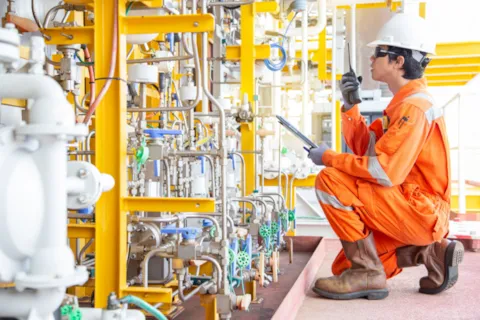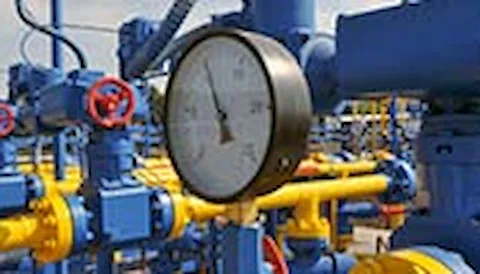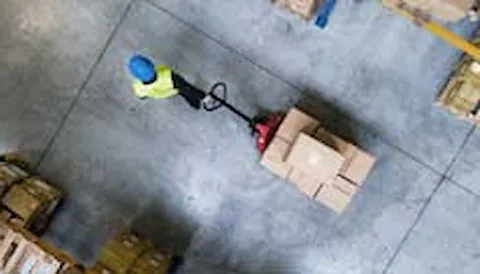LabTest Certification for Hazardous Locations (Ex) Equipment
We have aligned with LabTest Certification Inc. to form a one-stop solution for Hazardous Locations (Ex) Equipment testing, certification, and factory assessment around the globe. As a result, manufacturers of all sizes and industry types can benefit from reduced approval costs, faster time to market, localized technical expertise, and international market acceptance.
LabTest Certification for Hazardous Locations (Ex) Equipment
1. Requirement
Code of Federal Regulations from OSHA (Occupational Safety and Health Administration) requires equipment and wiring used in Hazardous (Classified) Locations meet Class, Division or Class, Zone requirements following CFR 1910.307.
NFPA 70 (National Electrical Code) covers the requirements of electrical, electrical equipment, and wiring for all voltages where fire or explosion hazards may exist due to flammable gases, flammable liquid-produced vapors, combustible liquid-produced vapors, combustible dusts, or ignitable fibers/flyings. Within this standard, Hazardous (Classified) Locations are covered in Chapter 5, Special Occupancies in Article 500, 501, 502, 503, 504, 505, and 506.
Please note: All definitions below are from NFPA 70:2020
NFPA 70®: National Electrical Code®
2. DNV Capability
DNV collaborates with LabTest Certification Inc as an alliance to provide Hazardous Locations (Ex) Equipment Testing, Certification, and Factory Assessments for multi-National schemes. Though this collaboration, DNV will be able to provide North American Hazardous Locations Product Certification to our clients separately or with global certification using IECEx, ATEX, INMETRO, or North American schemes. If a global product acceptance is needed, typically IECEx certification forms the basis to apply for other certifications. This method of using IECEx saves time to market. DNV can also prioritize certain certification schemes such as North American Certifications as part of a global certification project.
3. Basic Technical Concepts
3.1 Classification of Locations
Locations shall be classified depending on the properties of the flammable gas, Flammable liquid-produced vapor, combustible liquid-produced vapors, combustible dusts, or fibers/flyings that could be present, and the likelihood that a flammable or combustible concentration or quantity is present. Each room, section, or area shall be considered individually in determining its classification. NFPA 497 and NFPA 499 are the standards utilized to identify these areas for gases and dusts respectively.
3.2 Class I - Divisions
Class I Locations: Flammable gases, flammable liquid-produced vapors, or combustible liquid-produced vapors are or may be present in the air in quantities sufficient to produce explosive or ignitable mixtures
- Class I, Division 1:
- Flammable gases, flammable liquid-produced vapors, or combustible liquid-produced vapors can exist under normal operating conditions, or
- Flammable gases, flammable liquid-produced vapors, or combustible liquid-produced vapors above their flash points may exist frequently because of repair or maintenance operations or because of leakage, or
- Breakdown or faulty operation of equipment or processes might release ignitable concentrations Flammable gases, flammable liquid-produced vapors, or combustible liquid-produced vapors.
- Class I, Division 2:
- In which volatile flammable gases, flammable liquid-produced vapors, or combustible liquid-produced vapors are handled, processed, or used, but in which the liquids, vapors, or gases will normally be confined within closed containers or closed systems from which they can escape only in case of accidental rupture or breakdown of such containers or systems or in case of abnormal operation of equipment, or
- In which ignitable concentrations of flammable gases, flammable liquid-produced vapors, or combustible liquid-produced vapors are normally prevented by positive mechanical ventilation and which might become hazardous through failure or abnormal operation of ventilating equipment, or
- Adjacent to a class I, Division 1 location, and to which ignitable concentrations of flammable gases, flammable liquid-produced vapors, or combustible liquid-produced vapors above their flash points might occasionally be communicated unless such communication is prevented by adequate positive-pressure ventilation from a source of clean air and effective safeguards against ventilation failure are provided.
3.3 Class I - Zones
Class I, Zone 0, 1, and 2 Locations: Flammable gases or vapors are or may be present in the air in quantities sufficient to produce explosive or ignitable mixtures.
- Class I, Zone 0
- Ignitable concentrations of flammable gases or vapors are present continuously.
- Ignitable concentrations of flammable gases or vapors are present for long periods of time.
- Class I, Zone 1:
- Ignitable concentrations of flammable gases or vapors are likely to exist under normal operating conditions, or
- Ignitable concentrations of flammable gases or vapors may exist frequently because of repair or maintenance operations or because of leakage, or
- Equipment is operated or processes are carried on, of such a nature that equipment breakdown or faulty operations could result in the release of ignitable concentrations of flammable gases or vapors and also because simultaneous failure of electrical equipment to become a source of ignition, or
- Adjacent to a Class I, Zone 0 location from which ignitable concentrations of vapors could be communicated, unless communication is prevented by adequate positive pressure ventilation from a source of clean air and effective safeguards against ventilation failure are provided.
- Class I, Zone 2:Ignitable concentrations of flammable gases or vapors or they do occur, will exist only for a short period, or
- Volatile flammable liquids, flammable gases, or flammable vapors are handled, processed, or used but in which the liquids, gases, or vapors normally are confined within closed containers of closed systems from which they can escape, only as a result of accidental rupture or breakdown of the containers or system, or a result of the abnormal operation of the equipment with the liquids or gases are handled, processed, or used, or
- Ignitable concentrations of flammable gases or vapors normally are prevented by positive mechanical ventilation, but which may become hazardous as a result of failure or abnormal operation of the ventilation equipment, or
- Adjacent to Class I, Zone 1 location from which ignitable concentrations for vapors could communicated, unless communication is prevented by adequate positive pressure ventilation from a source of clean air and effective safeguards against ventilation failure are provided.
3.4 Class II
Class II Locations: Locations that are hazardous because of the presence of combustible dust.
- Class II, Division 1:
- Combustible dust is in the air under normal operating conditions in quantities sufficient to produce explosive or ignitable mixtures, or
- Mechanical failure or abnormal operation of machinery or equipment might cause such explosive or ignitable mixtures to be produced, and might also provide a source of ignition through simultaneous failure of electrical equipment, though operation of protection devices or from other causes, or
- In which combustible metal dusts may be present in quantities sufficient to be hazardous.
- Class II, Division 2:
- Combustible dust due to abnormal operations may be present in the air in quantities sufficient to produce explosive or ignitable mixtures, or
- Combustible dust accumulations are present but are normally insufficient to interfere with the normal operation of electrical equipment or other apparatus, but could as a result of infrequent malfunctioning of handling or processing equipment become suspended in the air, or
- Combustible dust accumulations on, in, or in the vicinity of the electrical equipment could be sufficient to interfere with the safe dissipation of heat from electrical or could be ignitable by abnormal operation or failure of electrical equipment.
3.5 Class III
Class III: Hazardous location with the presence of easily ignitable fibers or where materials producing combustible flyings are handled, manufactured, or used, but in which such fibers/flyings are not likely to be in suspension in the air in quantities sufficient to produce ignitable mixtures.
- Class III, Division 1:
- Easily ignitable fibers/flyings are handed or used.
- Easily ignitable fibers/flyings are handed or used.
- Class III, Division 2:
- Easily ignitable fibers/flying are stored or handled other than in the process of manufacturer.
3.6 Zone 21, 21, 22
Zone 20, Zone 21, and Zone 22: Locations are those in which combustible dust or ignitable fibers/flyings are or may be present in the air or in layers, in quantities sufficient to produce explosive or ignitable mixtures.
- Zone 20:
- Ignitable concentrations of combustible dust or ignitable fibers/flyings are present continuously.
- Ignitable concentrations of combustible dust or ignitable fibers/flyings are present for long periods of time.
- Zone 21:
- Ignitable concentrations of combustible dust or ignitable fibers/flyings are likely to exist occasionally under normal operating conditions, or
- Ignitable concentrations of combustible dust or ignitable fibers/flyings may exist frequently because of repair or maintenance operations or because of leakage, or
- Equipment is operated or processes are carried on, of such a nature that equipment breakdown or faulty operation could result in the release of ignitable concentrations of combustible dust or ignitable fibers/flyings and also cause simultaneous failure of electrical equipment in a mode to cause the electrical equipment to become a source of ignition, or
- Location is adjacent to a Zone 20 location from which ignitable concentrations of dust or ignitable fibers/flyings could be communicated.
- Zone 22:
- Ignitable concentrations of combustible dust or ignitable fibers/flyings are not likely to occur in normal operation and, if they do occur, will only persist for a short period, or
- Combustible dusts or fibers/flyings are handled, processed, or used but in which the dust or fibers/flyings are normally confined within closed containers of closed system from which they can escape only as a result of of the abnormal operation of the equipment with which the dust or fibers/flyings are handled, processed, or used, or
- Location is adjacent to a Zone 21 location, from which ignitable concentrations of dust or fibers/flyings could be communicated.
3.7 Equipment Protection Techniques - Divisions
Electrical equipment installed into a hazardous location must meet one or more of the following protection techniques:- 3.7.1 Explosionproof Equipment
This protection technique shall be permitted for equipment in Class I, Division 1 or 2.
- 3.7.2 Dust Ignitionproof
This protection technique shall be permitted for equipment in Class I, Division 1 or 2 locations.
- 3.7.3 Dusttight
This protection technique shall be permitted for equipment in Class II, Division 2 or Class IIII, Division 1 or 2 locations.
- 3.7.4 Purged and Pressurized
This protection technique shall be permitted for equipment in any hazardous (classified) location for which it is identified.
- 3.7.5 Intrinsic Safety
This protection technique shall be permitted for equipment in class I, Division 1 or 2; or Class II, Division 1 or 2; or Class III, Division 1 or 2 locations.
- 3.7.6 Nonincendive Circuit
This protection technique shall be permitted for equipment in Class I, Division 2; Class II, Division 2; or Class III, Division 1 or 2 locations.
- 3.7.7 Nonincendive Equipment
This protection technique shall be permitted for equipment in Class I, Division 2; Class II, Division 2; or Class III, Division 1 or 2 locations.
- 3.7.8 Nonincendive Component
This protection technique shall be permitted for equipment in Class I, Division 2; Class II, Division 2; or Class III, Division 1 or 2 locations.
- 3.7.9 Oil Immersion
This protection technique shall be permitted for current-interrupting contacts in Class I, Division 2 locations.
- 3.7.10 Hermetically Sealed
This protection technique shall be permitted for equipment in Class I, Division 2; Class II, Division 2; or Class III, Division 1 or 2 locations.
- 3.7.11 Combustible Gas Detection System
A combustible gas detection system shall be permitted as a means of protection in industrial establishments with restricted public access and where the conditions of maintenance and supervision ensure that only qualified persons service the installation.
- 3.7.12 Inherently Safe Optical Radiation “op is”
This protection technique shall be permitted for equipment in Class I or II, Division 1 or 2 locations for which the equipment is identified.
- 3.7.13 Protected Optical Radiation “op pr”
This protection technique shall be permitted for equipment in Class I or II, Division 2 locations for which the equipment is identified.
- 3.7.14 Optical System with Interlock “op sh”
This protection technique shall be permitted for equipment in Class I or II, Division 1 or 2 locations for which the equipment is identified.
- 3.7.15 Protection by Skin Effect Trace Heating “IEEE 844.1”
This protection technique shall be permitted for skin effect trace heating equipment in Class I, Division 2; Class II, Division 2; or Class III, Division 2 for which it is listed.
3.8 Equipment protection techniques – Zones 0, 1, or 2
Electrical equipment installed into a hazardous location must meet one or more of the following protection techniques:
- 3.8.1 Flameproof Enclosure “d”
This protection technique shall be permitted for equipment in Zone 1 or Zone 2 locations.
- 3.8.2 Pressurized Enclosure “p”
This protection technique shall be permitted for equipment in those Zone 1 or Zone 2 locations for which it is identified.
- 3.8.3 Intrinsic Safety “i”
This protection technique shall be permitted for apparatus and associated apparatus for Zone 0, Zone 1, or Zone 2 Locations.
- 3.8.4 Type of Protection “n”
This protection technique shall be permitted for equipment in Zone 2 locations. Type of protection “n” is further subdivided into nA, nC, and nR.
- 3.8.5 Liquid Immersion “o”
This protection technique shall be permitted for equipment In Zone 1 or Zone 2 locations.
- 3.8.6 Increased Safety “e”
This protection technique shall be permitted for equipment in Zone 1 or Zone 2 locations.
- 3.8.7 Encapsulation “m”
This protection technique shall be permitted for equipment in Zone 0, Zone 1, or Zone 2 locations for which it is identified.
- 3.8.8 Powder Filling “q”
This protection technique shall be permitted for equipment in Zone 1 or Zone 2 locations.
- 3.8.9 Combustible Gas Detection System
A combustible gas detection system shall be permitted as a means of protection in industrial establishments with restricted public access and where the conditions of maintenance and supervision ensure that only qualified person service the installation.
- 3.8.10 Protection by Electrical Resistance Trace Heating “60079-30-1”
This protection technique shall be permitted for electrical resistance trace heating equipment in Zone 1 or Zone 2 for which it is listed.
- 3.8.11 Inherently Safe Optical Radiation “op is”
This protection technique shall be permitted for equipment in Zone 0, Zone 1, or Zone 2 locations for which the equipment is identified.
- 3.8.12 Protected Optical Radiation “op pr”
This protection technique shall be permitted for equipment in Zone 1 or Zone 2 locations for which the equipment is identified.
- 3.8.13 Optical System with Interlock “op sh”
This protection technique shall be permitted for equipment in Zone 0, Zone 1, or Zone 2 locations for which the equipment is identified.
- 3.8.14 Protection by Skin Effect Trace Heating “IEEE 844.1”
This protection technique shall be permitted for skin effect trace heating equipment in Zone 1 or Zone 2 for which it is listed.
3.9 Equipment protection techniques – Zones 20, 21, or 22
Electrical equipment installed into a hazardous location must meet one or more of the following protection techniques:- 3.9.1 Dust ignitionproof
This protection technique shall be permitted for equipment in Zone 20, Zone 21, and Zone 22 locations for which it is identified.
- 3.9.2 Pressurized
This protection technique shall be permitted for equipment in those Zone 21 or Zone 22 locations for which it is identified.
- 3.9.3 Intrinsic Safety
This protection technique shall be permitted for apparatus and associated apparatus for Zone 20, Zone 21, or Zone 22 Locations.
- 3.9.4 Dusttight
This protection technique shall be permitted for equipment in Zone 22 locations for which it is identified.
- 3.9.5 Protection by Encapsulation “m”
This protection technique shall be permitted for equipment in Zone 20, Zone 21, and Zone 22 locations for which it is identified.
- 3.9.6 Nonincendive Equipment
This protection technique shall be permitted for equipment in Zone 22 locations for which it is identified.
- 3.9.7 Protection by Enclosure “t”
This protection technique shall be permitted for equipment in Zone 20, 21, and Zone 22 locations for which it is identified.
- 3.9.8 Protection by Pressurized Enclosure “p”
This protection technique shall be permitted for equipment in Zone 21 and Zone 22 locations for which it is listed.
- 3.9.9 Protection by Intrinsic Safety “i”
This protection technique shall be permitted for equipment in Zone 20, Zone 21, and Zone 22 locations for which it is listed.
- 3.9.10 Protection by Electrical Resistance Trace Heating “60079-30-1”
This protection technique shall be permitted for electrical resistance trace heating equipment in Zone 21 or Zone 22 for which it is listed.
- 3.9.11 Inherently Safe Optical Radiation “op is”
This protection technique shall be permitted for equipment in Zone 20, 21, or 22 locations for which the equipment is identified.
- 3.9.12 Protection Optical Radiation “op pr”
This protection technique shall be permitted for equipment in Zone 21 or Zone 22 locations for which the equipment is identified.
- 3.9.13 Optical System with Interlock “op sh”
This protection technique shall be permitted for equipment in Zone 20, 21 or 22 locations for which the equipment is identified.
- 3.9.14 Protection by Skin Effect Trace Heating “IEEE 844.1”
This protection technique shall be permitted for skin effect trace heating equipment in Zone 21 or Zone 22 for which it is listed.
Common Standards
- UL/CSA 60079-0 General Requirements
- UL/CSA 60079-1 Flameproof Ex d
- UL/CSA 60079-2 Pressurization Ex p
- UL/CSA 60079-5 Quartz-filled Ex q
- UL/CSA 60079-6 Oil-filled Ex o
- UL/CSA 60079-7 Increased Safety Ex e
- UL/CSA 60079-11 Intrinsic Safety Ex i
- UL/CSA 60079-15 Type of protection n Ex n
- UL/CSA 60079-18 Encapsulation Ex m
- UL/CSA 60079-28 Optical Radiation Ex op
- UL/CSA 60079-31 Dust Protection by Enclosure Ex t
- NFPA 496 Purged and pressurized
- UL 913 Intrinsically safe
- UL 1203 Explosionproof
- UL 121201 Nonincendive
- CSA C22.2 No. 157 Intrinsically safe and non-incendive equipment
- CSA C22.2 No. 213 Non-incendive equipment
- CSA C22.2 No. 30 Explosionproof


